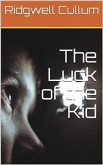Gobseck is an 1830 novella by French author Honoré de Balzac (1799-1850) and included in the Scènes de la vie privée section of his novel sequence La Comédie humaine. Gobseck first appeared in outline form in La Mode in March 1830 under the title l’Usurier (The Usurer), and then in August 1830 in the periodical Le Voleur. The actual novel appeared in a volume published by Mame-Delaunay under the title les Dangers de l’inconduite. This novel would appear in 1835 under the title of Papa Gobseck in a volume published by Madame Charles-Béchet. The definitive title of Gobseck would appear in 1842 in the Furne edition of La Comédie humaine.
The plot of Gobseck, set during the French Restoration, concerns Anastasie de Restaud, née Goriot. Anastasie de Restaud is the daughter of a rich bourgeois who has married into the aristocracy, but is bored by her marriage, which is loveless and passionless.
Anastasie de Restaud has an affair with Maxime de Trailles, and spends her fortune on de Trailles. She turns to the usurer Jean-Esther van Gobseck for financial assistance. Maître Derville acts as Gobseck’s lawyer. Subsequently, both Anastasie's marriage is destroyed and her family fortune is lost.
"'Daddy Gobseck,' I began, 'is intimately convinced of the truth of the principle which he takes for a rule of life. In his opinion, money is a commodity which you may sell cheap or dear, according to circumstances, with a clear conscience. A capitalist, by charging a high rate of interest, becomes in his eyes a secured partner by anticipation. Apart from the peculiar philosophical views of human nature and financial principles, which enable him to behave like a usurer, I am fully persuaded that, out of his business, he is the most loyal and upright soul in Paris. There are two men in him; he is petty and great—a miser and a philosopher…”
—Honoré de Balzac, Gobseck
The plot of Gobseck, set during the French Restoration, concerns Anastasie de Restaud, née Goriot. Anastasie de Restaud is the daughter of a rich bourgeois who has married into the aristocracy, but is bored by her marriage, which is loveless and passionless.
Anastasie de Restaud has an affair with Maxime de Trailles, and spends her fortune on de Trailles. She turns to the usurer Jean-Esther van Gobseck for financial assistance. Maître Derville acts as Gobseck’s lawyer. Subsequently, both Anastasie's marriage is destroyed and her family fortune is lost.
"'Daddy Gobseck,' I began, 'is intimately convinced of the truth of the principle which he takes for a rule of life. In his opinion, money is a commodity which you may sell cheap or dear, according to circumstances, with a clear conscience. A capitalist, by charging a high rate of interest, becomes in his eyes a secured partner by anticipation. Apart from the peculiar philosophical views of human nature and financial principles, which enable him to behave like a usurer, I am fully persuaded that, out of his business, he is the most loyal and upright soul in Paris. There are two men in him; he is petty and great—a miser and a philosopher…”
—Honoré de Balzac, Gobseck









